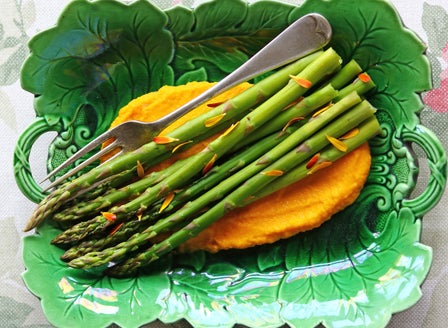Few things taste more delicious and tender than steamed asparagus stems picked fresh from the garden. What's great is that once established they can provide masses of these tasty treats every summer for years and years to come. Asparagus is a delicious perennial crop harvested throughout spring.
Planting Calendar
Asparagus can be planted from August through until October.
Harvest In
2 Years
Start harvesting after the asparagus plants have been planted for 2 years. The first year’s shoots will need to be left to go to fern. You can cut a few spears, but it will give the plants more strength for future harvests if most are left. In the second year, harvest half your crop and leave the rest to fern again. In the third year you will be away! Stop harvesting in December and allow the plants to go to fern. In autumn, remove all fern and lay on the bed to mulch into the ground. Cut the spears when they are 15-20 cm long and before the tip opens.
Prepare
Position
A sunny site that can be used permanently for this crop and is free of weeds is ideal. Choose a garden bed or area to be your asparagus patch. An established bed can produce for up to 20 years so choose your site carefully. Ensure that you can access the bed easily for both weeding and harvesting.
Soil
Asparagus likes to be planted in free-draining soil, rich in compost and organic matter. Start preparing your soil in late autumn. Dig down at least 30cm and aerate the soil, mix into the soil plenty of organic matter such as King Organic Compost, Kings Sheep Pellets and Kings Natures Organic Fertiliser. In heavier clay soils, where drainage is likely to be an issue, plant onto a raised mound and sprinkle Gypsum Clay Breaker into the bottom of the hole, this helps slowly condition the soil and help to break down the clay.
Plant
You can start planting as soon as the Asparagus Crowns become available – to do so, dig a hole and in the bottom make a small mound over which you can spread the roots of the asparagus crown. Place each crown 45cm apart. Fill in the hole with a mixture of soil and compost and cover with mulch to keep weeds at bay. You can also grow asparagus from seed and seedlings. You can start sowing seeds into a seedling tray from early spring. They generally take between 25-30 days under optimum conditions. To germinate they require the soil to be fairly warm, so for best results grow in a propagator, or a windowsill, or in a greenhouse.
Care
Watering
Water is important for good crops. Water well and deeply in the drier months of the year.
Feeding
Feed in autumn and spring with Kings Liquid Fast Food. To keep the soil fertile, sprinkle Kings Sheep Pellets over the asparagus beds after the ferns have been cut back. Where possible mulch with Pea straw and Lucerne (this will help suppress weeds and add organic matter to the soil). Monthly applications of Aquaticus Organic Garden Booster will ensure healthy strong plants and roots.
Protecting
Asparagus need protecting from Root Rot therefore it is imperative that you have free draining asparagus beds. In heavier clay soils, where drainage is likely to be an issue, plant onto a raised mound and sprinkle Gypsum Clay Breaker into the bottom of the hole, this helps slowly condition the soil and help to break down the clay.
Mulching
Mulch around your crowns with Pea Straw and Lucerne. Mulching helps to reduce weeds as well as aiding the soil to retain moisture
Spraying
Rust can at times be a problem, if this occurs pop into your local store and they will show you the correct product.
Pruning
In autumn, remove all fern and lay on the bed to mulch into the ground. Cut the spears when they are 15-20 cm long and before the tip opens.
General Care
When using sprays, chemicals or fertilisers always read the label and follow the instructions. Apply sprays in the evening to avoid harming beneficial insects.
Tip
As the tip of the spear breaks the surface, push a sharp knife through the soil to cut the spear.
Frequently Asked Questions
When is the best time to plant asparagus?
The best time to plant asparagus is during the winter months, from June to August. This allows the crowns to establish before the growing season begins.
How often should I water asparagus?
Water is important for good crops. Water well and deeply in the drier months of the year.
When can I start harvesting asparagus?
Start harvesting after the asparagus plants have been planted for 2 years. Stop harvesting in December and allow the plants to go to fern. In autumn, remove all fern and lay on the bed to mulch into the ground. Cut the spears when they are 15-20 cm long and before the tip opens.
How do I harvest asparagus?
The first year’s shoots will need to be left to go to fern. You can cut a few spears, but it will give the plants more strength for future harvests if most are left. In the second year, harvest half your crop and leave the rest to fern again. In the third year you will be away!
What pests and diseases affect asparagus?
Asparagus can be affected by asparagus beetles, slugs, and snails. Rust and fusarium wilt are common diseases. Regular monitoring and proper garden hygiene can help manage these issues.

